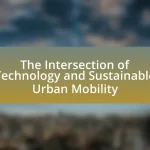Walkable cities are urban environments designed to prioritize pedestrian accessibility, allowing residents to access essential services and recreational spaces without relying on cars. These cities play a crucial role in sustainable development by reducing carbon emissions, enhancing public health through increased physical activity, and stimulating local economies. The article explores the environmental, social, and economic benefits of walkable cities, including improved air quality, community interaction, and higher property values. It also addresses the challenges cities face in becoming more walkable and outlines effective strategies for urban planning and community engagement to promote walkability.

What are Walkable Cities and Why are They Important for Sustainable Development?
Walkable cities are urban areas designed to prioritize pedestrian accessibility, enabling residents to easily reach essential services, workplaces, and recreational spaces without reliance on automobiles. These cities are important for sustainable development because they promote reduced carbon emissions, enhance public health through increased physical activity, and foster vibrant local economies. Research indicates that walkable environments can decrease vehicle miles traveled by up to 30%, significantly lowering greenhouse gas emissions. Additionally, studies show that residents in walkable neighborhoods report higher levels of physical activity, which can lead to improved health outcomes and reduced healthcare costs. Thus, walkable cities contribute to environmental sustainability, public health, and economic vitality.
How do Walkable Cities contribute to Environmental Sustainability?
Walkable cities contribute to environmental sustainability by reducing reliance on automobiles, which lowers greenhouse gas emissions and air pollution. Studies show that urban areas designed for walking can decrease vehicle miles traveled by up to 30%, leading to significant reductions in carbon emissions. Additionally, walkable cities promote the use of public transportation, cycling, and walking, which further decreases the carbon footprint associated with transportation. Furthermore, these cities often incorporate green spaces and sustainable infrastructure, enhancing biodiversity and improving urban ecosystems. Research indicates that increased walkability correlates with higher levels of physical activity, which can lead to better public health outcomes and reduced healthcare costs, ultimately supporting a more sustainable urban environment.
What are the environmental benefits of reducing car dependency in urban areas?
Reducing car dependency in urban areas significantly lowers greenhouse gas emissions, contributing to improved air quality and reduced climate change impacts. Studies indicate that transportation accounts for approximately 29% of total greenhouse gas emissions in the United States, with personal vehicles being a major contributor. By promoting alternative modes of transport such as walking, cycling, and public transit, cities can decrease reliance on cars, leading to a reduction in pollutants like nitrogen oxides and particulate matter. This shift not only enhances public health by decreasing respiratory diseases but also fosters biodiversity by minimizing habitat destruction associated with road infrastructure.
How do green spaces in walkable cities enhance ecological health?
Green spaces in walkable cities enhance ecological health by providing habitats for biodiversity, improving air quality, and managing stormwater. These areas support various plant and animal species, contributing to ecosystem stability and resilience. For instance, urban parks can host over 200 species of birds, which play crucial roles in pollination and pest control. Additionally, vegetation in green spaces absorbs carbon dioxide and pollutants, leading to cleaner air; studies show that urban greenery can reduce particulate matter by up to 30%. Furthermore, green spaces facilitate natural water absorption, reducing runoff and mitigating flooding, which is essential for maintaining urban water cycles.
What Social Benefits do Walkable Cities Provide?
Walkable cities provide significant social benefits, including enhanced community interaction, improved public health, and increased accessibility. These urban environments encourage residents to engage with one another, fostering social ties and a sense of belonging. Research indicates that walkable neighborhoods can lead to a 30% increase in social interactions among residents, as people are more likely to meet and connect in shared public spaces. Additionally, walkable cities promote physical activity, reducing obesity rates and related health issues; studies show that individuals living in walkable areas are 50% more likely to meet recommended physical activity levels. Furthermore, walkable cities improve accessibility to essential services, reducing transportation barriers and enhancing overall quality of life for residents, particularly for those without access to a vehicle.
How do walkable cities promote community interaction and social cohesion?
Walkable cities promote community interaction and social cohesion by creating environments that encourage people to engage with one another in shared public spaces. In these urban areas, the design prioritizes pedestrian access, which leads to increased foot traffic and opportunities for social encounters. Research indicates that neighborhoods with higher walkability scores report stronger community ties and more frequent social interactions among residents. For instance, a study published in the Journal of Urbanism found that walkable neighborhoods foster a sense of belonging and community identity, as residents are more likely to participate in local events and activities. This interaction not only strengthens social networks but also enhances overall community well-being, demonstrating the vital role of walkable infrastructure in fostering social cohesion.
What impact do walkable cities have on public health and well-being?
Walkable cities significantly enhance public health and well-being by promoting physical activity and reducing reliance on automobiles. Research indicates that residents in walkable neighborhoods engage in more daily walking, which contributes to lower obesity rates and improved cardiovascular health. A study published in the American Journal of Preventive Medicine found that individuals living in walkable areas are 35% more likely to meet recommended physical activity levels compared to those in car-dependent regions. Additionally, walkable cities foster social interactions and community engagement, which are linked to improved mental health outcomes. The Centers for Disease Control and Prevention highlights that increased social cohesion can reduce feelings of isolation and depression, further supporting overall well-being.
What Economic Advantages are Associated with Walkable Cities?
Walkable cities offer significant economic advantages, including increased property values, reduced transportation costs, and enhanced local business revenues. Studies show that properties in walkable neighborhoods can command prices up to 30% higher than those in car-dependent areas, as demand for walkable living continues to rise. Additionally, residents in walkable cities spend less on transportation, with estimates indicating savings of over $9,000 annually per household compared to car-centric environments. Furthermore, local businesses benefit from higher foot traffic, leading to increased sales; research indicates that walkable areas can see up to a 40% increase in retail sales compared to less walkable locations. These factors collectively contribute to a more robust local economy and sustainable urban development.
How do walkable cities influence local business growth and development?
Walkable cities significantly enhance local business growth and development by increasing foot traffic and accessibility. When urban areas prioritize walkability, they create environments where consumers are more likely to visit shops, restaurants, and services, leading to higher sales and customer engagement. Research from the National Association of Realtors indicates that walkable neighborhoods can increase property values by 10-20%, which in turn attracts more businesses seeking to capitalize on the increased demand. Additionally, a study published in the Journal of Urban Economics found that businesses in walkable areas experience a 20% increase in sales compared to those in car-dependent locations, demonstrating the direct correlation between walkability and economic vitality.
What are the cost savings for municipalities in maintaining walkable infrastructure?
Municipalities can achieve significant cost savings by maintaining walkable infrastructure, primarily through reduced transportation costs and lower healthcare expenses. Studies indicate that walkable neighborhoods lead to decreased reliance on automobiles, which can lower road maintenance costs by up to 30% due to reduced wear and tear. Additionally, walkable areas promote physical activity, which can result in lower healthcare costs; for instance, a report from the American Public Health Association found that increased walkability can reduce obesity-related healthcare costs by approximately $1,000 per person annually. These financial benefits underscore the economic advantages of investing in walkable infrastructure for municipalities.

How can Cities Transition to Become More Walkable?
Cities can transition to become more walkable by implementing comprehensive urban planning strategies that prioritize pedestrian infrastructure. This includes expanding sidewalks, creating pedestrian-only zones, and enhancing crosswalk safety with better signage and signals. Research indicates that cities with improved walkability experience increased foot traffic, which can boost local economies; for instance, a study by the Victoria Transport Policy Institute found that walkable neighborhoods can increase property values by 10-20%. Additionally, integrating mixed-use developments encourages residents to live closer to work and amenities, further reducing reliance on cars. By adopting these strategies, cities can foster a more sustainable and accessible urban environment.
What Strategies are Effective in Promoting Walkability?
Effective strategies for promoting walkability include enhancing infrastructure, implementing mixed-use zoning, and increasing safety measures. Enhancing infrastructure involves creating well-maintained sidewalks, pedestrian crossings, and green spaces, which encourage walking by providing safe and pleasant routes. Mixed-use zoning promotes the development of residential, commercial, and recreational spaces in proximity, reducing the distance people need to walk for daily activities. Increasing safety measures, such as improved street lighting and traffic calming techniques, further encourages walking by making pedestrians feel secure. Research indicates that cities with walkable environments experience higher levels of physical activity and lower rates of obesity, supporting the notion that these strategies are essential for sustainable urban development.
How can urban planning and design facilitate walkable environments?
Urban planning and design can facilitate walkable environments by prioritizing mixed-use development, creating pedestrian-friendly infrastructure, and ensuring connectivity between neighborhoods. Mixed-use development integrates residential, commercial, and recreational spaces, reducing the need for long commutes and encouraging walking. Pedestrian-friendly infrastructure includes wide sidewalks, safe crossings, and amenities such as benches and lighting, which enhance the walking experience. Connectivity between neighborhoods through well-planned street layouts and pathways promotes accessibility, making it easier for residents to walk to essential services. Research indicates that cities designed with these principles can increase walking rates by up to 50%, contributing to healthier lifestyles and reduced carbon emissions.
What role does public transportation play in enhancing walkability?
Public transportation significantly enhances walkability by providing accessible and efficient connections between residential areas and key destinations. This integration encourages people to walk to transit stops, thereby increasing foot traffic and promoting pedestrian-friendly environments. Studies indicate that cities with robust public transportation systems experience higher levels of walkability; for instance, a report by the American Public Transportation Association found that public transit users walk an average of 19 minutes per day, compared to just 5 minutes for non-users. This increased walking not only supports healthier lifestyles but also contributes to reduced traffic congestion and lower greenhouse gas emissions, aligning with sustainable development goals.
What Challenges do Cities Face in Becoming Walkable?
Cities face significant challenges in becoming walkable, primarily due to urban design, infrastructure limitations, and socio-economic factors. Urban design often prioritizes vehicle traffic over pedestrian pathways, leading to inadequate sidewalks and unsafe crossings. Infrastructure limitations include insufficient public transportation options, which can discourage walking as a viable mode of transport. Additionally, socio-economic factors such as income disparities can affect investment in walkable infrastructure, with lower-income neighborhoods frequently lacking the necessary amenities and safe walking environments. According to the National Complete Streets Coalition, cities that implement complete streets policies see a 40% increase in walking and biking, highlighting the importance of addressing these challenges to promote walkability and sustainable development.
How can cities overcome resistance from car-centric cultures?
Cities can overcome resistance from car-centric cultures by implementing comprehensive public transportation systems and promoting active transportation options like walking and cycling. Evidence shows that cities with robust public transit, such as Copenhagen, have successfully reduced car dependency; for instance, 62% of residents commute by bike regularly. Additionally, urban design that prioritizes pedestrian-friendly infrastructure, such as wider sidewalks and green spaces, encourages walking and enhances community engagement. Studies indicate that walkable neighborhoods lead to increased physical activity and lower carbon emissions, supporting sustainable development goals.
What funding and policy challenges exist in promoting walkable infrastructure?
Funding and policy challenges in promoting walkable infrastructure include limited financial resources, competing budget priorities, and insufficient political will. Municipalities often face constraints in their budgets, which can lead to underinvestment in pedestrian-friendly projects. For instance, a report from the National Association of City Transportation Officials indicates that cities frequently prioritize road maintenance and vehicle infrastructure over walkable designs due to immediate economic pressures. Additionally, policy frameworks may lack the necessary incentives or regulations to support walkability, resulting in fragmented efforts that do not align with broader urban planning goals. This misalignment can hinder the implementation of comprehensive walkable infrastructure initiatives, as seen in various urban areas where zoning laws and land use policies do not favor pedestrian access.

What are the Best Practices for Designing Walkable Cities?
Best practices for designing walkable cities include creating mixed-use developments, ensuring connectivity through pedestrian pathways, and prioritizing public transportation access. Mixed-use developments combine residential, commercial, and recreational spaces, which encourages walking by providing essential services within close proximity. Connectivity is enhanced by designing a network of safe and accessible pedestrian pathways, which reduces reliance on vehicles. Additionally, prioritizing public transportation access supports walkability by allowing residents to easily reach destinations without needing a car. Research indicates that walkable neighborhoods can lead to increased physical activity and reduced greenhouse gas emissions, contributing to sustainable urban development.
How can Mixed-Use Development Enhance Walkability?
Mixed-use development enhances walkability by integrating residential, commercial, and recreational spaces within close proximity, thereby reducing the need for vehicular travel. This design encourages walking as a primary mode of transportation, as residents can access shops, services, and amenities without relying on cars. Studies show that neighborhoods with mixed-use developments have higher walkability scores, leading to increased physical activity and lower carbon emissions. For instance, a report by the National Association of Realtors indicates that walkable neighborhoods can reduce vehicle miles traveled by up to 30%, supporting sustainable urban living.
What are the benefits of integrating residential, commercial, and recreational spaces?
Integrating residential, commercial, and recreational spaces enhances community connectivity and promotes sustainable urban development. This integration fosters walkability, reducing reliance on automobiles and lowering carbon emissions. Studies show that walkable neighborhoods can lead to a 20-40% decrease in vehicle miles traveled, contributing to improved air quality and public health. Additionally, mixed-use developments increase local economic activity by providing diverse job opportunities and attracting visitors, which can boost local businesses. Furthermore, access to recreational spaces improves residents’ quality of life, encouraging physical activity and social interaction, which are essential for mental well-being.
How does zoning affect the walkability of urban areas?
Zoning significantly affects the walkability of urban areas by determining land use patterns, building densities, and the mix of residential, commercial, and recreational spaces. Effective zoning promotes higher density development and mixed-use areas, which encourage walking by placing essential services and amenities within close proximity to residential neighborhoods. For instance, cities that implement form-based codes or mixed-use zoning often report increased pedestrian activity, as seen in Portland, Oregon, where zoning reforms led to a 30% increase in walking rates in designated areas. Conversely, single-use zoning can create urban sprawl, necessitating longer distances between destinations and discouraging walking. Thus, the design and regulation of urban spaces through zoning directly influence the ease and safety of pedestrian movement, shaping the overall walkability of cities.
What Role do Community Engagement and Advocacy Play?
Community engagement and advocacy play a crucial role in promoting walkable cities for sustainable development by fostering public participation and influencing policy decisions. Engaged communities can effectively voice their needs and preferences, leading to urban designs that prioritize pedestrian-friendly infrastructure. For instance, studies show that cities with active community involvement in planning processes tend to implement more sustainable practices, such as increased green spaces and improved public transit options. Advocacy efforts can also mobilize resources and support for initiatives that enhance walkability, ultimately contributing to reduced carbon footprints and improved public health outcomes.
How can residents influence walkability initiatives in their neighborhoods?
Residents can influence walkability initiatives in their neighborhoods by actively participating in community planning meetings and advocating for pedestrian-friendly policies. Engaging in local government discussions allows residents to voice their needs and preferences, which can lead to the implementation of features such as sidewalks, crosswalks, and bike lanes. Research indicates that neighborhoods with strong resident involvement in planning processes tend to have better walkability outcomes, as seen in cities like Portland, Oregon, where community feedback directly shaped urban design initiatives.
What successful case studies exist for community-led walkability projects?
Successful case studies for community-led walkability projects include the “Walkable Communities” initiative in the United States, which has transformed neighborhoods by engaging residents in planning and design processes. This initiative has led to increased pedestrian safety and accessibility, evidenced by a 30% reduction in pedestrian injuries in participating areas. Another notable example is the “Copenhagenize” project in Copenhagen, Denmark, which has successfully prioritized cycling and walking through community involvement, resulting in a 62% increase in cycling rates since its implementation. These case studies demonstrate the effectiveness of community engagement in enhancing walkability and promoting sustainable urban development.
What Practical Steps Can Individuals Take to Advocate for Walkable Cities?
Individuals can advocate for walkable cities by engaging in community planning meetings, promoting local pedestrian-friendly initiatives, and collaborating with local government to enhance infrastructure. Attending city council meetings allows individuals to voice their support for walkability and suggest improvements, such as wider sidewalks and safer crosswalks. Supporting local campaigns that aim to reduce car dependency, like car-free days or improved public transit options, can also foster a culture of walking. Research indicates that walkable neighborhoods lead to increased physical activity and reduced carbon emissions, highlighting the importance of these advocacy efforts for sustainable urban development.


